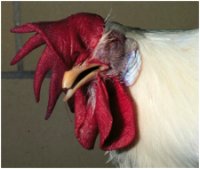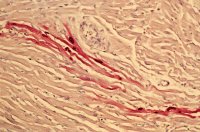The specified bovine offals-we did not stop importing immediately. However, bovine products are used in numerous pharmaceutical producst, cosmetics, shoe and floor polish, and candles, to name a few.
A whole nation of beef eaters had to change their ways. This gives an idea of the number of brains that have been examined in the US. Of close to 500 cattle were imported into the US prior to 1989, there are only 17 left. We have tried to buy all of them and kill them and examine their brains, but these few left have just become incredibly expensive. USDA has decided, well, we'll just send an inspector out there once a week to make sure that cow does not go anywhere. That would be cheaper
We mentioned about this smuggled British beef. At least 10,000 tons of British beef have been sold to the European continent.

Creutzfeldt-Jacob disease and BSE: Are they the same agent?
In October 1997 there were two articles in Nature that essentially sealed the fate of BSE being linked positively to new variant Creutzfeldt-Jacob disease. They did research to show that yes, these are in fact the same agents. There have only been 23 cases of new variant Creutzfeldt-Jacob, however it is expected that there may be between 100 and 1,500 human cases in total.
Differences in Variations of Creutzfeldt-Jacob disease
|
nvCJD |
CJD |
| Age |
young |
old |
| Disease course |
prolonged |
rapid |
| Clinical disease |
behavioral changes |
dementia |
| Prp plaques |
frequent |
infrequent |
Differences between new variant Creutzfeldt-Jacob disease and the sporadic Creutzfeld-Jacob disease are obvious. Sporadic CJD usually affects older people, 60-70 years, whereas in new variant CJD there are teenagers or young adults who are affected. The mean age of death for nvCJD is 28 years old. It has a long incubation time and disease course. The presenting signs are psychiatric and behavioral changes, many patients are initially treated by psychologists and psychiatrists. The histology of the brain is also different. In the new variant Creutzfeldt-Jacob disease, there are many amyloid plaques throughout the brain which is not present in the sporadic form of the disease.
[Question: Are people still feeding ruminants the meat and bone meal?]
Most places in the world are no longer feeding ruminant meat and bone meal to ruminants. The carcasses have to be burned now, so we may see some environmental consequences of getting rid of the extra ruminant material.
[Question: What about the United States?]
We banned the feeding of sheep and goat meat and bone meal to cattle when the BSE outbreak started in 1989. We banned the feeding of ruminant meat and bone meal, it was a voluntary ban that lasted three or four years, now I believe it is a mandatory ban. It is costing us a lot of money, because now in our post-mortem room, we now have to burn all of those carcasses. They cannot go for dog food anymore, and it costs about $1 per pound to burn, so you are talking about a few 500 pound cows per week, it is expensive, and there are going to be people who try to find their way around regulations because of economics.

Avian Influenza
We will talk briefly about the highly pathogenic avian influenza. We had a big outbreak of highly pathogenic avian influenza in birds in the United States in 1983 and 1984. We killed 17 million birds to control it. It cost the US $63 million to eradicate it. An economic study was done, and found that if we did not eradicate it, over the course of a year, US consumers would pay another $5 billion for poultry products and eggs. How did it get into the US? We see highly pathogenic avian influenza around the world periodically. We know that there are a lot of high pathogenic strains out there that will cause disease, but this particular virus was strange. This virus came from ducks. It was an avirulent virus until there was a single point mutation that caused the whole virus to become virulent. This was a spontaneous genetic mutation. It arose right here in the US. Influenza viruses are all part of the orthomyxoviridae family, their hemagglutinin and their neuraminadases, the H and the N gene characterize them.

Hong Kong H5N1
Virtually all of the highly pathogenic avian influenza strains are either H5 or H7. That big one that we had in Pennsylvania in 1983 and 84 that killed 7 million chickens, that was H5N2. To classify a virus as highly pathogenic, means that it causes a lot of mortality in chickens. These viruses usually have a very short incubation period.

The birds tend to have these very swollen wattles or combs, with edema of the head. They may have hemorrhage along their shanks, and then they die. They are usually dead within three to four days. The pathogenesis of this strain H5N2 is identical to the pathogenesis of the Hong Kong strain H5N1. The most characteristic finding is edema around the head.
How Does It Kill Them? 
Initially the respiratory epithelium is infected, from there it spreads to the blood vessels. Once in the blood vessels, the capillaries throughout the body become infected. Within 24-48 hours the virus has multiplied enough to cause capillary leakage and bursting throughout the body. In can cause necrosis of the brain and the heart. This is very similar to the large influenza epidemic in 1918.
How Is It Transmitted?
It is an airborne virus that appears to be transmitted from waterfowl, i.e. ducks, to chickens. The ducks are usually not affected by the virus. The waterfowl migrate and spread the disease where they go. The majority of serious influenza diseases is usually due to chicken and pig influenza viruses mixing with the human influenza strains. This is how most of the influenza epidemics start, 1968 Hong Kong flu, 1976 Swine flu, and the 1918 flu.
How Does This Relate to the Hong Kong outbreak?
There has never been a case of avian influenza getting into humans and causing disease before. There have been several cases of swine influenza that have gotten into humans and caused limited person transmission, but this avian influenza is a first. Of the 18 cases in humans, there have been 6 fatalities. This is a bad flu. In order to control the outbreak, Hong Kong authorities decided to kill all the chickens. Over 1.6 million chickens were slaughtered within 2 days. Some of the transmission may have occurred due to the practices in the live animal markets where ducks, geese and chickens cohabitate thereby allowing transmission to occur. They have shown that this particular H5N1 strain is in the geese and the ducks also. The potential for further spread among the waterfowl and the chickens continues to exist.
[Question: Is someone trying to correlate the migration of certain types of water fowl with these problems?]
I think the only people who are working on that are the USDA at the Southeast Poultry Research Lab.

Wrapping Up Disease Transmission Across Species Boundaries
Crossing species boundaries
- domestication
- zoological collections
- population pressures
- eco-tourisem
I think that the possibilities for disease transmission through this avenue are only increasing. We are domesticating a lot more species than ever, we are mixing species together. Our zoological collections, we are continually mixing species from different parts of the world, maybe species that are not evolutionarily compatible with one another. Population pressures in the world are absolutely unrelenting. We are close to 6 billion people in the world. Everybody has to have a place to work, place to play, place to live, and we are just really pressing the environment. Ecotourism where a lot of people are going to remote areas to view endangered species. This is very good for the local economy, and it increases the visibility of these species, but how long will it be before we take measles or influenza or rhinoviruses to these groups that are really very immunologically privileged. The reverse is also possible where humans may be exposed to potentially dangerous viruses from the wildlife.
Technology and Xenotransplantation: Example of Pig Transplants
Xenotransplantation is one of the best examples of biotechnology and potential for cross species infections. One can take hearts and kidneys from a genetically altered pig and put them into humans. We have to draft protocols for how to insure that these pigs are free of any diseases that might go into humans. How about if you took a person with a heart lung transplant, and they got swine influenza that then mixed with their human influenza and started a big outbreak. Talk about the perfect place to produce brand new diseases. But these transplant surgeons had no idea.

